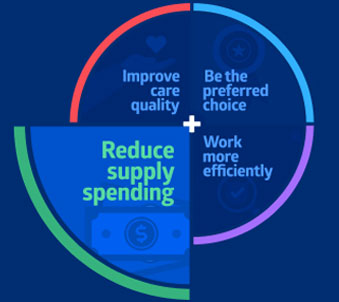
Insight
Inventory forecasting—the practice of predicting future demand for products—is never easy. It’s a challenge for any industry, but for hospitals during the COVID-19 pandemic, predicting demand for medical supplies felt nearly impossible. With so many variables beyond their control, from challenges in their supply chains to unpredictable demand, they couldn’t rely on their existing strategies for inventory forecasting.
For the surgical departments across Legacy Health, a large health system spanning the Pacific Northwest and British Columbia, they faced shortages of custom surgical packs. Legacy leveraged their partnership with Medline to dramatically reduce the average number of weekly shortages. The partners achieved this success through cooperation, information sharing and data-driven decision making.
Organization
Partnership profile:
Legacy Health, a locally owned, non-profit health system based in the Portland and Vancouver metro areas and mid-Willamette Valley, is comprised of six hospitals, a mental and behavioral health service center and more than 70 primary care, specialty and urgent care clinics. They provide comprehensive healthcare services to over 2.5 million people.
Challenges
- Faced an average shortage of 12 custom surgical packs per week
- Shortages led to time-consuming process of staff having to pull individual supplies and less time for care
Actions
- Set up a custom reporting system with a minimum of 25 data points
- Implemented weekly inventory reports, monthly reviews of needs and capacity, and quarterly forecasting
- Interviewed physicians and surgical staff as an integral part of forecasting process
- Used data to isolate the variables Medline and Legacy could control
Results
- Improved forecasting reduced average shortages of custom surgical packs to two every six months, a 99% decrease
- Received an SMI Tom Hughes Collaboration Award Honorable Mention
Outdated datasets for inventory forecasting
Inventory forecasting is all about predicting demand. Many health systems had inventory forecasting formulas that were created prior to the pandemic. This made it a challenge to get an accurate inventory forecast.
This was exactly the challenge Legacy Health’s surgery departments were facing in December 2021. “We were constantly running out of custom surgical packs,” said Jeff Elliot, Legacy Health Demand Planning and Business Continuity Program Manager. “We were short approximately 12 packs a week required to meet our operating room needs.”
These packs are designed to save staff the amount of time it takes to pull individual supplies off shelves, and without them, they have less time to deliver care. With caregivers spread so thin, this extra demand on their time was even more challenging.
99%
decrease in average number of custom surgical pack shortages over a 6-month period.
25 data points
gathered for a new custom reporting system to improve forecasting.
How to forecast inventory: Collaborating to find a better dataset
Elliot and Medline worked together to identify the “rolling, three-month forecasting window used to determine demand and forecasting” as the cause of the shortages. “The dataset was problematic given that surgeries were cancelled, and operating rooms shut down during the pandemic.”
They set up a better forecasting method. The partners developed a custom reporting system that gathered a minimum of 25 data points to improve inventory planning and more accurately predict demand. The system pulled data from weekly surgical kit inventory supply reports and monthly reviews of needs and capacity, and they implemented a model based on a quarterly forecast period. This data was supplemented with feedback from physicians and surgical staff.
“The goal is to do quarterly forecasting so we can stay on top of demand,” said Elliot. “We also let Medline know in advance if there are going to be any operational changes. If, for some reason, Medline sees demand isn’t meeting the forecast, they flag it, and we discuss the change in forecast before adjusting the production,” he added.
Learn more about our Supply Chain Optimization strategies for inventory forecasting and tracking
“This experience helped us isolate problems that we could fix—controllable versus non-controllable—and make impactful changes.”
Kevin Rocha
Acute care rep, Medline
Medline-Legacy partnership results in a 99% decrease custom surgical pack shortages
The close collaboration between Medline and Legacy paid off dramatically. After the changes, the system reported an average of two custom surgical pack shortages over six months—a 99% decrease in average shortages.
Industry leaders took note of the impressive results achieved through this provider-supplier collaboration. The partnership was given an honorable mention for the SMI Tom Hughes Collaboration Award, an award given by a non-profit, member-driven community of healthcare provider and industry partner organizations.
Elliot attributes these impressive results to Medline’s willingness to work closely with Legacy and overcome the challenges around custom surgical kits. They were successful as a result of collaborative forecasting and “better communication and transparency,” according to Elliot. He added, “Medline also was very open to embracing the lean principles that we were in the process of adopting and using.”
Trent Larsen, Legacy Health Director of Supply Chain Logistics, reiterated Elliot’s view of the partnership. “Open and honest transparency when discussing internal process gaps and challenges, from both sides, is a must,” according to Larsen. He went on to say that “surgery leadership, staff and physician participation were essential to achieve a higher level of collaboration, transparency and trust with our Medline partners.”
Ginger Henry, Vice President of Supply Chain, agreed that the open dialogue benefits both parties. Henry says, “The supplier is not over producing, and the customer has the products they need when they need them.”
We understand the challenges you face with staying on top of demand and never running out of the supplies you need to deliver high-quality care. It’s our goal to help facilities focus on care and reduce costs. That’s why we support them with forecasting and purchasing strategies customized to their needs. Explore how a partnership with Medline can help you optimize your performance to achieve results.





